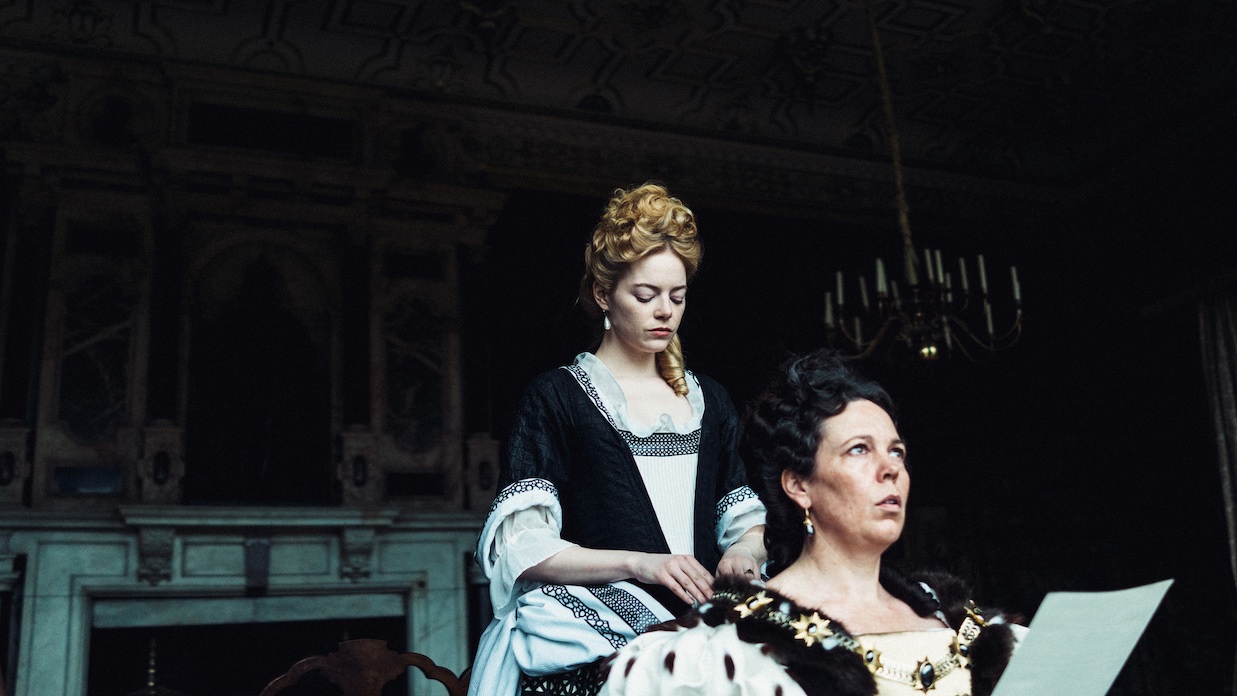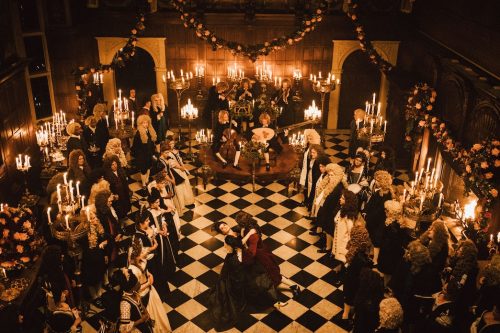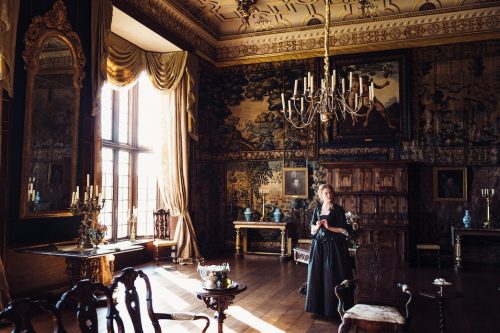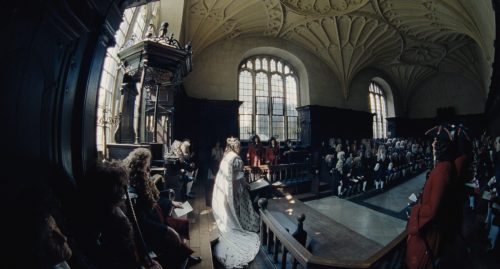 Back to selection
Back to selection
Shutter Angles
Conversations with DPs, directors and below-the-line crew by Matt Mulcahey
“Lights are Your Friends, but Sometimes They Don’t Need to Come Around to the Party”: Cinematographer Robbie Ryan on Shooting Yorgos Lanthimos’s The Favourite
 Emma Stone and Olivia Colman in The Favourite. Photo by Yorgos Lanthimos. © 2018 Twentieth Century Fox Film Corporation.
Emma Stone and Olivia Colman in The Favourite. Photo by Yorgos Lanthimos. © 2018 Twentieth Century Fox Film Corporation. In Yorgos Lanthimos’s The Favourite, two determined women — Rachel Weisz’s refined but ruthless Duchess of Marlborough and Emma Stone’s desperate and cunning chambermaid Abigail — vie for the titular preferential position alongside the ill and melancholy Queen Anne. Anyone expecting a beautifully mounted but stuffy 18th century period piece has not seen a Yorgos Lanthimos movie.
Employing the same absurdist sense of humor as Lanthimos’s The Lobster, The Favourite also imposes the director’s preferred set of aesthetic restrictions — namely, wide angle lenses and shooting almost entirely with available light. Irish cinematographer Robbie Ryan (American Honey, Fish Tank), who was recently nominated for an American Society of Cinematographers Outstanding Achievement Award, spoke to Filmmaker about embracing Lanthimos’s singular sensibility, the difficulty of shaking off Yorgos’s style, and why he sleeps like a baby when shooting film.
Filmmaker: Rachel Weisz said in an interview that Yorgos would never talk about character motivation. How does that affect your job? For example, the final image of the film — I don’t want to go into too much detail for people who haven’t seen it yet — is a superimposition of two images. Do you need to understand the metaphor behind that superimposition?
Ryan: Interesting question. Yorgos is a director who wouldn’t necessarily let on what he’s thinking. I don’t know if he would even know himself. Those motivations are probably more based on things he’s instinctually coming out with. And to be honest with you, we never talked about [that final superimposition]. That was something that Yorgos and the editor [Yorgos Mavropsaridis] came up with.
Filmmaker: Just because of the setting, the extreme wide lenses, and all the candlelight, The Favourite made me think of Barry Lyndon. Kubrick was famous for doing a huge number of takes to get certain shots the way he wanted them. Is Yorgos similar? Will he do 30 takes of something to get it exactly like he sees it in his head?
Ryan: He isn’t a director who does an indulgent number of takes. He usually wouldn’t go over ten takes of any one thing, and if we did it was usually because something [technical] was going wrong. It wouldn’t necessarily have to do with the performances. He was very confident in his team of actors to give him what he needed. So no, we didn’t do a lot of takes. I think we actually came in under budget on stock, which surprised the producers.

Filmmaker: Yorgos preferred using available light for The Favourite. What situations required exceptions?
Ryan: It was really only for some of the nighttime sequences. For the dance sequence in the great hall [pictured above] we did have a bit of supplemental light because it was such a big space. We really tried to shoot it with candles, but eventually we realized it might just need a bit of help. Yorgos was very keen not to use lights. Only in extreme circumstances where it was very, very necessary would he even think about using a light. (laughs) He knows film stock really well. He’s got a cinematographer’s mind. He’s shot enough to know what he can get away with and how far a stock can be pushed. From a DP’s point of view, you’re always using lights because you think that’s the thing to do, but in Yorgos’s world he knows that the look he can get with no lighting is much more pleasing to him.
Filmmaker: Was the truck still fully stocked or did you have a pared-down package?
Ryan: In prep there was that conversation where I said, “Well, you’ve got to have a few lights.” Because I hadn’t worked with Yorgos before, I didn’t know if he was really going to have the conviction to [use mostly natural light]. So we started with a few lights at the beginning of the shoot, but when we realized we really weren’t going to use them we minimized the kit to a very small amount of gear.
Filmmaker: So was there a truck full of electrics trying to entertain themselves for weeks on end?
Ryan: (laughs) No, not really. It was just the gaffer [Andy Cole] plus, I think, two or three [additional crewmembers] and then he would get more people if there were an occasion where we might need some lighting. Andy did have to deal with a lot of candles. We made all these candle rigs where we would get a load of candles, stick them together, and wrap a reflector around them. We went through a few models. The first model — Candleholder 1.0 — was great, but what we didn’t realize was candles melt really quickly, and we would end up with this huge tray full of melted wax that was slopping around. It would spill over onto the very expensive parquet floor of the house and it was like, “Shit! Clean that up before anybody sees!” (laughs). So then Andy perfected a model that was less precarious with the melted wax.

Filmmaker: Not using lights is one thing, but you weren’t even really shaping the light with bounces or flags or even diffusing it.
Ryan: There were some scenes shot up against three big windows, and when you’re doing that it’s very hard to not just have the actors silhouetted. Normally the idea would be that you’d fill the actors in a bit to balance out [the difference in light levels between the actors and the window], but that’s exactly what Yorgos didn’t want to do. He absolutely adored blown-out windows. When we were getting the dailies back, the grader was trying to tone down how blown out the windows were and by doing that the windows in the grade went a bit purple and Yorgos got frustrated because all he wanted was the blown-out whites. What I realized is that when you film a person against the window and you expose for their face, the highlights almost wrap around them and it creates a beautiful white halo of burn out. Yorgos had done The Lobster on digital and really couldn’t get that look, and he hasn’t liked digital ever since then. He really loves film and one of the reasons is that film sort of burns out beautifully.
I’m working on a digital film at the moment and I’m looking at the rushes everyday and saying, “Wow, there’s so much information in the shadows,” but when you see quite a bright source on a face you say, “That’s really quite garish.” That’s where you tend to have to do a bit of work to the final image. Film kind of minimizes the amount of work you have to do in post, whereas digital opens up a huge amount of ideas about what you could do.
Filmmaker: I was reading about the Coen Brothers’ experience shooting digital for the first time on The Ballad of Buster Scruggs and they talked about how they felt like they were just “capturing information” to decide in the DI how the movie would look.
Ryan: Absolutely. I’ve never quite got my head around how instantaneous digital is. Literally right there on set you can grade it straight away and that process by itself makes it a little less magical. A lot of people say they have sleepless nights [when they shoot film], because they don’t know how the exposure will work out. But I always sleep pretty well. (laugh) Film gives you a little bit of time before you see [the footage] again, and I don’t mind that. It’s a stay of grace where you sort of forget about it and then [when the dailies arrive] it either comes back to haunt you or comes back to surprise you.
Filmmaker: Did Yorgos’s way of working seep into your next project or did you, like, immediately puke the truck and start throwing up every light you had?
Ryan: (laughs) The thing I couldn’t shake off was the wide lenses we used on The Favourite. The next movie I did was a Noah Baumbach film for Netflix, and I kept trying to get Noah to use them, but his filmmaking is an entirely different type of filmmaking. So it was a tough one to shake because Yorgos’s style is so distinctive that once you get into it you really enjoy it. It’s an exciting way to film. But for Noah’s film we shot a lot in a lawyer’s office, and we were like 10 stories high, and the daylight would go and we’d have to shoot the reverse to make it still look like a sunny day. So lights were my friends on Noah’s film. And lights are your friends, but sometimes they don’t need to come around to the party.
Filmmaker: How did you handle similar situations on The Favourite? If you’re shooting a scene in the Queen’s bedroom, which has these giant windows, what do you do if the sun goes behind the clouds for a half hour? Do you just have to wait it out?
Ryan: We were very blessed with the weather. It was a very sunny spring, so it was consistently quite bright. We usually had a good amount of daylight to get scenes done and then we’d go into nighttime scenes to fill out the [shooting day]. There was one day where we had really bad weather, and that’s where I did say to Yorgos, “I think I might need to put a light in there to get exposure.” He fought against it at first before he said, “Okay, it looks a bit dark. Let’s do it.”
Filmmaker: Did you spend a lot of time in prep figuring out which rooms in the Hatfield House estate would work best at certain times of day?
Ryan: Yorgos had been prepping this film a year in advance because they were going to shoot it earlier, but then Olivia Colman [who plays Queen Anne] and Emma Stone’s schedules delayed the film. So he’d already done a lot of research into locations and found Hatfield House and it had all been sort of worked out. It’s a fantastic house and it’s been shot a lot on other projects, but I think the way we approached it was pretty unique.
My prep on The Favourite was more about figuring out what kind of equipment we would use, things like whether we would be on a dolly on a normal head or would it be a remote head. We discovered this gimbal rig called the Double Helix. A lot of people use MōVI rigs with digital cameras, but those cameras are very light. The Double Helix is a gimbal rig that can take the weight of a 35mm camera. It did get used quite a bit in the film, but not as extensively as we may have thought at the start because it was a difficult piece of equipment to calibrate. So we ended up using the dolly quite a lot. But my prep was very much about finding lenses and then camera-centric things, not so much lighting.

Filmmaker: Tell me about this 6mm Panavision lens you used. [You can see the lens at work in the image above.]
Ryan: Yorgos had used quite an extensive amount of wide lenses on The Killing of a Sacred Deer and he’d used a 10mm lens from Panavision on that. He really fell in love with their 10mm and wanted to use that as his go-to normal lens for The Favourite. [Editor’s note: A 50mm lens would typically be considered a “normal” lens when shooting 35mm film.] And by the end of the shoot it did feel like quite a normal lens to us. The great thing about Panavision is they never sell their lenses. They’re a rental company so they’ve got an extensive amount of lenses going back years. Their main office in London has quite a few older lenses that we had a chance to look at. That 6mm lens just suited the absurd world that The Favourite exists in.
Filmmaker: That lens opens to a T2.8 Could you shoot it wide open or did it go to hell if you didn’t stop down?
Ryan: No, no, we shot it wide open all the time. It didn’t have any aberrations or anything when we went wide open. It was really a good bit of glass. A beautiful lens.
Filmmaker: I read that the field of view was greater than 180 degrees on that lens, so I guess it was good you weren’t using lights because that doesn’t give you a lot of places to hide them.
Ryan: It was a lens that cleared the room, I can tell you that. (laughs) And the way that we were doing all of these whip pans meant that the whole room was sometimes seen, which was great for the actors. It was almost like a theater piece because they didn’t have to be constricted. They were free to do whatever they wanted.
Filmmaker: How tricky are those pans to nail? Are you using wheels to operate or just the pan handle?
Ryan: Well, the one thing I can say that I brought to the film is that I can do a good pan. (laughs) But they are tricky to do. I used a normal head, because I’m really bad at the wheels.
Filmmaker: To finish up, tell me about the night exterior scene where Harley (Nicholas Hoult) propositions Abigail (Emma Stone) to be his spy in the Royal Palace as they stroll along the palace grounds. Is that a situation that required you to bring in some lights?
Ryan: There’s a bit of a story behind that. I had to take a week off because my father died, God bless him. So I unfortunately had to leave the shoot for a week and this other DP called Stephen Murphy [filled in]. So I wasn’t around for that particular scene, but I had organized it with my gaffer and we had it all set up. We planned to have exterior lighting to put up as a moonlight sort of thing. And this is classic Yorgos, apparently he turned all those lights off. (laughs) He got the production designer Fiona [Crombie] to put all these brasiers down, which are like big fire drums, and they shot it all with that.
Tech Details
Cameras: Panaflex Millennium XL2, Arricam ST and LT
Lenses: A set of Panavision Primos and a Panavision SF6 fisheye lens
Film stocks: Kodak Vision3 500T 5219, 200T 5213, and 50D 5203
Matt Mulcahey works as a DIT in the Midwest. He also writes about film on his blog Deep Fried Movies.
